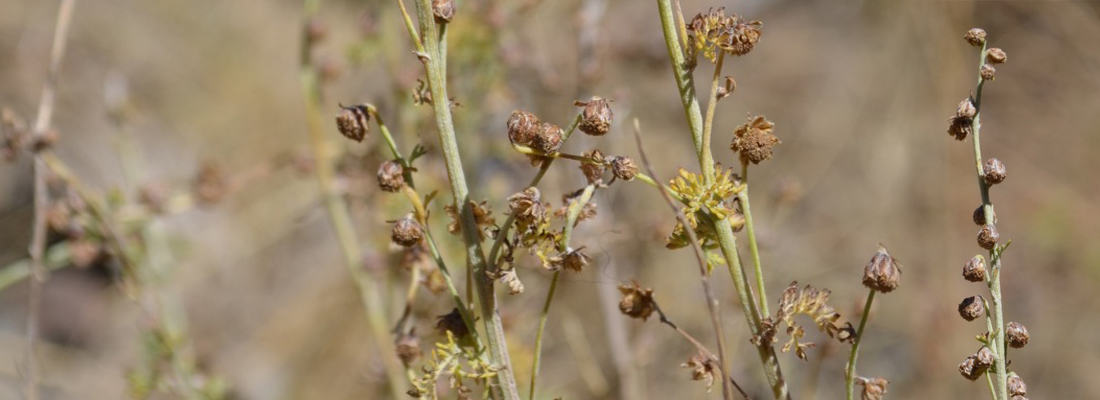Artemisia persica

The genus Artemisia comprises over 500 species and is among the largest genera within the Asteraceae (Compositae) family, widely distributed throughout the temperate zones of Europe, Asia, and North America. These plants exhibit diverse forms including perennial, biennial, and annual herbs or small shrubs.
General morphological characteristics of this genus include alternate leaves, small capitula arranged in racemose, paniculate, or capitate inflorescences, rarely solitary. Phyllaries occur in few rows and are sometimes hirsute; florets are all tubular, producing small, dry, indehiscent fruit [1].
Artemisia persica is a densely greyish tomentose, basally woody shrublet, 25–75 cm tall, with ascending or upright, simple or branched, striate-costate stems that are densely leafy and rarely glabrescent, originating from a much-branched woody rootstock. Leaves are 3-pinnatisect with lobulate primary and secondary rachises; basal and lower stem leaves have petioles up to 1.5 cm long, with oblong-obovate lamina measuring 1.2–3.5 (–4.5) × 0.8–2 cm. Primary segments are ascending to patent; ultimate segments are linear-oblong to lanceolate, 1.5–2.5 × 0.5–0.8 (–1) mm, obtuse; upper leaves are sessile and gradually smaller, with the uppermost in the floral region being linear.
Capitula are heterogamous, borne on (1–) 2–4 mm long peduncles, remote, subglobose, approximately 3–3.5 mm long and broad, secund nodding within a narrow, ± oblong-pyramidal panicle up to 30 × 8–12 cm, featuring ascending to obliquely erect branches 6–20 cm long. The involucre is 3–4-seriate; phyllaries loosely imbricate and ± keeled; outermost phyllaries are linear-oblong, about 2 mm long; inner are elliptic, 2–2.5 × 0.75–1 mm, obtuse, hoary pubescent medially, with scarious margins. The receptacle is convex, densely to loosely long hairy or almost glabrous. Florets are all fertile and yellow, numbering 40–50; marginal florets 8–12 have compressed, approximately 0.8 mm long punctate-glandulose corolla tubes; disc florets are bisexual, 30–40, with 5-dentate, apically densely long hairy, 1–1.5 mm long corolla tubes. Cypselas are light brown, oblong, approximately 1 mm long, smooth [2].
Common names for Artemisia persica include Dermaneh (Persian), الشِّيحُ (Arabic), wormwood (English), and Armoise (French) [3].
Traditionally, Dermaneh leaves have been used for gastrointestinal, skin, and general ailments. Essential oil of Persian wormwood exhibits significant pharmacological and biological activities, including antioxidant, antibacterial, antifungal, antiparasitic, antinociceptive, and anti-anxiety effects. A. persica is rich in terpenoids such as bisabolol oxide derivatives, acetylenes, flavonoids, and coumarins [4, 5].
This species shows variation in essential oil components, including 1,8-cineole, camphor, davanone, α-pinene, and ocimenone. The chemical profile varies according to the plant’s origin and flowering time [6].
**Disclaimer: This content is for informational purposes only. It is not intended to provide medical advice or to replace advice or treatment from a qualified healthcare professional.
Applications and Benefits Across Various Industries:
The unique composition of Artemisia persica essential oil offers a wide range of benefits in the cosmetics, pharmaceutical, and perfumery industries. Key advantages in each sector include:
1- Cosmetics and Personal Care Industry
The bioactive compounds in Artemisia persica essential oil, such as cineole and camphor, deliver disinfecting, anti-inflammatory, and refreshing effects for skin and hair. Incorporating this essential oil into cosmetic formulations helps address various skin conditions such as acne and eczema while acting as a natural skin-protective agent.
Its fresh, herbal scent enhances cosmetic products like creams, shampoos, and natural soaps, offering consumers a refreshing and invigorating sensory experience. The oil’s antimicrobial and soothing properties make it effective in anti-acne serums and skin-calming treatments.
The cooling and anti-inflammatory effects of camphor make it ideal for after-sun products and post-shaving balms. Given its natural and organic profile, Artemisia persica essential oil aligns with the growing consumer demand for clean, sustainable, and plant-based skincare solutions.
2- Pharmaceutical Industry
The bioactive compounds present in Artemisia persica essential oil make it a valuable raw material for pharmaceutical and health-related products. Traditionally, Artemisia species have been used for their analgesic, anti-inflammatory, and disinfecting properties, as well as to support respiratory health.
1,8-Cineole acts as an expectorant, facilitating airway opening, useful in products targeting cold and cough relief. Camphor has a longstanding use in muscle pain relief ointments and massage oils due to its warming and numbing effects.
Modern research highlights the antimicrobial and potential anticancer properties of Artemisia essential oils, opening avenues for new medicinal product development. The oil’s anti-inflammatory and analgesic qualities also support its use in arthritis relief products and topical pain relievers.
Combining therapeutic effects with natural origin makes Artemisia persica essential oil particularly attractive to pharmaceutical companies developing plant-based active ingredients for modern healthcare.
3- Perfumery Industry
The complex and distinctive fragrance profile of Artemisia persica essential oil appeals to creative perfumers. Its aroma features:
- Herbal and spicy top notes from Artemisia ketone and thujone
- Fresh, camphorous middle notes from cineole and camphor
- Mild bitterness balanced with subtle sweetness
This combination creates a well-balanced, layered fragrance that is both natural and sophisticated.
As a fresh, herbal top note, this essential oil works beautifully in natural fragrances. In more luxurious perfumes, it adds depth and character to the middle notes, creating unique and memorable scents.
The rising trend toward rare and exotic botanical ingredients in modern perfumery positions Artemisia persica as an ideal choice for high-end and niche fragrances. Its long-lasting aromatic profile enhances fragrance longevity on the skin, while its fixative properties help stabilize other volatile compounds within the perfume blend.
References
1- M. Willcox, G. Bodeker, G. Bourdy, V. Dhingra, J. Falquet, J. F. Ferreira, B. Graz, H.-M. Hirt, E. Hsu and P. M. de Magalhães, Traditional medicinal plants and malaria 2004, 4, 43.
2- Flora of China @ efloras.org. World Flora Online Data. 2024.
3- S. Raghavan, 'Handbook of spices, seasonings, and flavorings', CRC press, 2006.
4- B F.Mirjalili; M H. Hakimi Meybody; M M. Ardakani; R. Abdolhossein. Journal of Essential Oil Research 2006,18, 544-547.
5- F. Moradi-Afrapoli, S N. Ebrahimi, M. Smiesko, M. Raith, S. Zimmermann, F. Nadjafi, R.Brun, M. Hamburger, Phytochemistry 2013, 85, 143-152.
6- Reza Dehghani Bidgoli, Journal of Food Science and Technology 2021, 58, 1313-1318.
